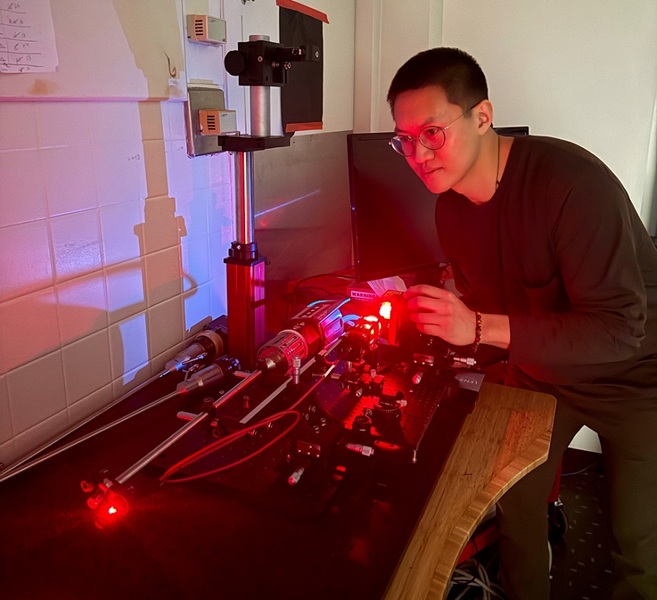New Laparoscopic Imaging Technique Accurately Maps Biological Tissue for Minimally Invasive Surgery
|
By HospiMedica International staff writers Posted on 19 Feb 2025 |

Laparoscopy, a minimally invasive surgical method, has become the standard approach for many procedures, including prostatectomies and appendectomies, thanks to its advantages such as faster recovery times, reduced scarring, and lower healthcare costs. However, the technique still faces challenges in visualization, particularly when it comes to identifying critical anatomical structures, assessing tissue perfusion, and distinguishing cancerous tissues. The limited field of view (FOV) and poor contrast in laparoscopic images often lead to subjective decision-making based on the surgeon’s experience, which can result in significant variability in clinical outcomes. These issues have driven research into optical technologies that offer more accurate and objective guidance for surgeons.
A research team from Johns Hopkins University (Baltimore, MD, USA) has now developed a new laparoscopic imaging tool to address these challenges by using advanced techniques to map tissue properties with high precision. The device integrates stereo depth estimation and speckle-illumination spatial frequency domain imaging (si-SFDI) to generate detailed optical property maps of tissues. Unlike traditional methods, this system employs a quantitative approach by measuring key properties such as absorption and scattering, enabling it to distinguish between healthy and cancerous tissue with high sensitivity and specificity.
As reported in the Journal of Biomedical Optics, the new system utilizes a compact two-camera laparoscope paired with a fiber-coupled laser to generate high-contrast speckle patterns on the tissue surface. These patterns enable the system to estimate optical properties without needing multiple images. This approach enhances measurement accuracy, especially for complex tissue geometries. Unlike earlier versions of si-SFDI, which required 10 or more images, this new method can acquire accurate data with only two image frames, making real-time mapping during surgical procedures feasible. This innovative technique offers surgeons a straightforward yet powerful tool to obtain quantitative optical property maps during laparoscopic procedures. By providing detailed tissue information, it could reduce reliance on subjective assessments, improve clinical outcomes, and enhance the precision of minimally invasive surgeries, potentially helping to identify critical tumor margins.
“Using a compact multimode fiber to generate laser speckle patterns makes speckle illumination spatial frequency domain imaging a compelling method for measuring wide-field quantitative optical properties over a large field of view, even in physically constrained settings such as minimally invasive surgery,” said Anthony Song, a graduate researcher from Johns Hopkins University.
Latest Surgical Techniques News
- New Transcatheter Valve Found Safe and Effective for Treating Aortic Regurgitation
- Minimally Invasive Valve Repair Reduces Hospitalizations in Severe Tricuspid Regurgitation Patients
- Tiny Robotic Tools Powered by Magnetic Fields to Enable Minimally Invasive Brain Surgery
- Magnetic Tweezers Make Robotic Surgery Safer and More Precise
- AI-Powered Surgical Planning Tool Improves Pre-Op Planning
- Novel Sensing System Restores Missing Sense of Touch in Minimally Invasive Surgery
- Headset-Based AR Navigation System Improves EVD Placement
- Higher Electrode Density Improves Epilepsy Surgery by Pinpointing Where Seizures Begin
- Open-Source Tool Optimizes Placement of Visual Brain Implants
- Easy-To-Apply Gel Could Prevent Formation of Post-Surgical Abdominal Adhesions
- Groundbreaking Leadless Pacemaker to Prevent Invasive Surgeries for Children
- Spectroscopy Technique Improves Surgery for Pediatric Epilepsy Patients
- Bioengineered Arteries Show Promise for Cardiovascular Surgery
- Online Tool Guides Surgical Decisions for Gallbladder Cancer
- Innovative Technology Enables Rapid Life-Saving Surgical Leak Detection
- First-Of-Its-Kind Bioresorbable Implant to Help Children with Rare Respiratory Disease
Channels
Critical Care
view channel
Mass Manufactured Nanoparticles to Deliver Cancer Drugs Directly to Tumors
Polymer-coated nanoparticles loaded with therapeutic drugs hold significant potential for treating cancers, including ovarian cancer. These particles can be precisely directed to tumors, delivering their... Read more
World’s Smallest Pacemaker Fits Inside Syringe Tip
After heart surgery, many patients require temporary pacemakers either to regulate the heart rate while waiting for a permanent pacemaker or to support normal heart rhythm during recovery.... Read more
AI-Powered, Internet-Connected Medical Devices to Revolutionize Healthcare, Finds Study
A new study suggests that artificial intelligence (AI)-powered, internet-connected medical devices have the potential to transform healthcare by enabling earlier detection of diseases, real-time patient... Read morePatient Care
view channel
Portable Biosensor Platform to Reduce Hospital-Acquired Infections
Approximately 4 million patients in the European Union acquire healthcare-associated infections (HAIs) or nosocomial infections each year, with around 37,000 deaths directly resulting from these infections,... Read moreFirst-Of-Its-Kind Portable Germicidal Light Technology Disinfects High-Touch Clinical Surfaces in Seconds
Reducing healthcare-acquired infections (HAIs) remains a pressing issue within global healthcare systems. In the United States alone, 1.7 million patients contract HAIs annually, leading to approximately... Read more
Surgical Capacity Optimization Solution Helps Hospitals Boost OR Utilization
An innovative solution has the capability to transform surgical capacity utilization by targeting the root cause of surgical block time inefficiencies. Fujitsu Limited’s (Tokyo, Japan) Surgical Capacity... Read more
Game-Changing Innovation in Surgical Instrument Sterilization Significantly Improves OR Throughput
A groundbreaking innovation enables hospitals to significantly improve instrument processing time and throughput in operating rooms (ORs) and sterile processing departments. Turbett Surgical, Inc.... Read moreHealth IT
view channel
Printable Molecule-Selective Nanoparticles Enable Mass Production of Wearable Biosensors
The future of medicine is likely to focus on the personalization of healthcare—understanding exactly what an individual requires and delivering the appropriate combination of nutrients, metabolites, and... Read more
Smartwatches Could Detect Congestive Heart Failure
Diagnosing congestive heart failure (CHF) typically requires expensive and time-consuming imaging techniques like echocardiography, also known as cardiac ultrasound. Previously, detecting CHF by analyzing... Read morePoint of Care
view channel
Handheld, Sound-Based Diagnostic System Delivers Bedside Blood Test Results in An Hour
Patients who go to a doctor for a blood test often have to contend with a needle and syringe, followed by a long wait—sometimes hours or even days—for lab results. Scientists have been working hard to... Read moreBusiness
view channel
Expanded Collaboration to Transform OR Technology Through AI and Automation
The expansion of an existing collaboration between three leading companies aims to develop artificial intelligence (AI)-driven solutions for smart operating rooms with sophisticated monitoring and automation.... Read more

















